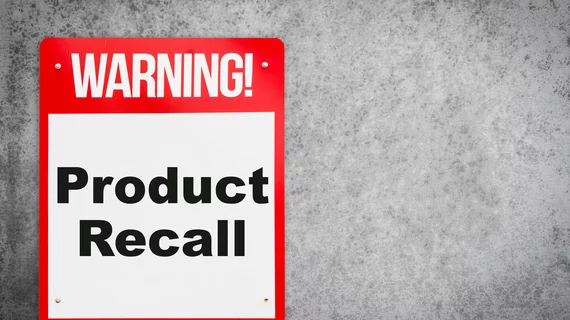Q&A: Why are cardiovascular devices involved in so many recalls? FDA policies may be to blame
Medical device recalls come in many forms. Class I recalls, for example, are reserved by the U.S. Food and Drug Administration (FDA) for serious safety issues that could result in a patient’s injury or death. The device in question is typically removed from the market, though in some cases adding new warnings or updating the instructions is enough to address the problem.
In the last decade, cardiovascular devices have been involved in more Class I recalls than any other device type. What, exactly, has led to this trend? Should cardiologists or their patients be concerned? And what can be done to limit these recalls going forward?
A team of researchers hoped to answer those questions, and many others, with a study recently published in Annals of Internal Medicine.[1] Tracking FDA data from 2013 to 2022, the group found that many recalled cardiovascular devices gained approval without ever submitting premarket or postmarket clinical data. Even when premarket testing was required, they explained, it often came in the form of a nonrandomized trial with no control arm, offering limited evidence of the device’s long-term safety or effectiveness.
Cardiovascular Business spoke to that study’s corresponding author, Kushal T. Kadakia, MSc, a healthcare policy researcher with Harvard Medical School, to learn more about this topic.
Read below for the full conversation:
Cardiovascular Business: You and your co-authors have been tracking Class I recalls for years now. Why is this such an important topic?
Kushal T. Kadakia, MSc: Class I recalls don’t happen that often, and they affect a very small proportion of devices available on the market, but they are very significant when they do occur. In fact, they can include hundreds of thousands or even millions of units. As you can imagine, it makes a pretty significant impact when that many devices are recalled, and there are a lot of safety implications to consider.
The risk of negative harm to patients, including death, associated with Class I recalls tends to attract a lot of attention from regulators because patients and their clinicians need to be alerted quickly. For example, if a pacemaker is recalled, it’s really important to alert clinicians and patients right away to enable informed decision-making and about their care.
Why are cardiovascular medical devices included in more Class I recalls than any other type of device?
I think it's difficult to speculate why cardiovascular devices in general—as compared to, say, devices in neurosurgery or gastroenterology—are more likely to be recalled. And I don’t want to promote the belief that cardiac devices are more unsafe than devices in other specialties. If anything, recalls are more common for cardiovascular devices for the simple reason that devices play a large part in modern cardiovascular care. We've been able to achieve so many strides in cardiac care and patient health over the past 50 years, and part of that progress has to do with the number of highly complex devices we use in the clinic, both for diagnosis and for treatment. It’s not unexpected that the devices we use the most may also have more safety risks that we identify and address as our experience with those devices grows.
With that being said, I do think it is notable that that a majority of cardiovascular devices involved in these Class I recalls are moderate-risk devices that were authorized via the 510(k) pathway. It’s a bit counterintuitive, because you would think the high-risk recalls would involve high-risk devices, but that has not been the case. Instead, we see many devices being recalled that were able to get to market with less rigorous clinical testing—or in some cases, no clinical testing at all. That brings up some questions. Are we appropriately risk stratifying these devices? Should the requirements for FDA approval be rebalanced?
This is why our team has been particularly interested in the 510(k) pathway. When you have a system where there are very few requirements for testing before devices get to market, and you have no requirement to monitor them after they get to market, you are going to have less information about those devices. There is no guarantee that testing will capture all safety risks, especially because clinical trials are not perfect encapsulations of real-world situations and some issues can take years to appear. However, our research suggests that more rigorous evidence generation for medical devices—including both the premarket and postmarket settings—is needed.
What other opportunities do you see for the FDA to improve its current policies and potentially limit cardiovascular device recalls in the future?
Our greatest hope for reform is the postmarket setting. It is astounding to me that we do not track devices in a standardized manner in the real world. Cardiology has been a leader when it comes to well-defined registries—the Society of Thoracic Surgeons and American College of Cardiology created the STS/ACC TVT Registry, for example—but those endeavors require significant time, resources, and labor, and not every device type has its own registry.
Something our team is really excited about is unique device identifiers, which can be used to track a specific device across the entire healthcare system. Congress asked for this in multiple pieces of legislation and FDA has spent a decade working on it—but it is entirely useless right now, because these identifiers have not been integrated into our broader healthcare system. It’s like every item in your grocery store getting a barcode, but then when a customer buys a box of cereal, the cashier is unable to scan the barcode.
For drugs, a universal labeling system has been in place for years now. It is particularly jarring that the same thing is not in place for medical devices, because that would improve safety and it could also help with device innovation. I hope our study can help provide some momentum for that kind of reform.
Any other key takeaways from your research you’d like to share?
There are a lot of efforts right now to expedite device innovation—and those are really welcome, because we know advances in device technology can make a big difference for patients and clinicians—but we have noticed some inconsistencies. For example, the FDA’s Breakthrough Devices Program and other similar programs typically have increased flexibility in the premarket stage with an expectation that there will be more data collection in the postmarket stage. However, researchers have raised concerns about the adequacy of those postmarket requirements in practice. It’s a cautionary tale for the importance of making sure you set up robust evidence-generation systems across the life cycle of a device.
I also want to acknowledge that the FDA has done a lot of great work to try to improve device safety, including working to reform the 510(k) pathway. Last September, the FDA issued three draft guidances that represented some of the biggest changes ever to that pathway, and we actually just published an analysis of those proposals.[2] A lot of pieces are starting to fit together, and I’m hopefully we will see some meaningful change soon.


